|
Size: 6514
Comment:
|
Size: 9825
Comment:
|
| Deletions are marked like this. | Additions are marked like this. |
| Line 33: | Line 33: |
| * The distribution contains 3 sub-directories of empty-room recordings of 3-5mins acquired at roughly the same time of year (spring 2009) as the 16 subjects. The sub-directory names are Year (first 2 digits), Month (second 2 digits) and Day (third 2 digits). Inside each are 2 raw *.fif files: one for which basic SSS has been applied by maxfilter in a similar manner to the subject data above, and one (*-noSSS.fif) for which SSS has not been applied (though the data have been passed through maxfilter just to convert to float format). | |
| Line 39: | Line 40: |
| * '''Requirements''': You have already followed all the introduction tutorials and you have a working copy of Brainstorm installed on your computer. | |
| Line 42: | Line 42: |
| * '''EmptyRoom''': Contains 3 sub-directories of empty-room recordings of 3-5mins acquired at roughly the same time of year (spring 2009) as the 16 subjects. The sub-directory names are Year (first 2 digits), Month (second 2 digits) and Day (third 2 digits). Inside each are 2 raw *.fif files: one for which basic SSS has been applied by maxfilter in a similar manner to the subject data above, and one (*-noSSS.fif) for which SSS has not been applied (though the data have been passed through maxfilter just to convert to float format). | * '''EmptyRoom''': MEG empty room measurements. * '''SubXX/MEEG/*_sss.fif''': MEG and EEG recordings in FIF format, corrected with SSS. * '''SubXX/MEEG/Trials''': Trials definition files. |
| Line 44: | Line 46: |
| * '''SubXX/T1''': T1 MR scan and digitized positions (fiducials and headpoints). * '''SubXX/MEEG''': MEG and EEG recordings in FIF format and triggers definition files. |
|
| Line 47: | Line 47: |
| * The output of the FreeSurfer segmentation of the T1 structural images are not part of this package. You can either process them by yourself, or download the result of the segmentation on this website. Go to the [[http://neuroimage.usc.edu/bst/download.php|Download]] page, and download the file: '''sample_group_anat.zip'''<<BR>>Unzip this file in the same folder where you downloaded all the datasets. * Do not put these downloaded files in any of the Brainstorm folders (program folder or database folder). This is really important that you always keep your original data files in a separate folder: the program folder can be deleted when updating the software, and the contents of the database folder is supposed to be manipulated only by the program itself. * Start Brainstorm (Matlab scripts or stand-alone version), see the [[Installation]] page. |
* The FreeSurfer segmentations of the T1 images are not part of this package. You can either process them by yourself, or download the result of the segmentation from the Brainstorm website. <<BR>>Go to the [[http://neuroimage.usc.edu/bst/download.php|Download]] page, and download the file: '''sample_group_anat.zip'''<<BR>>Unzip this file in the same folder where you downloaded all the datasets. * Reminder: Do not put the downloaded files in the Brainstorm folders (program or database folders). * Start Brainstorm (Matlab scripts or stand-alone version). For help, see the [[Installation]] page. |
| Line 63: | Line 63: |
| * In the coordinates panel, click on "'''Click here to compute MNI transformation'''". <<BR>>This step should take a few minutes, after it you should see the three referencial points AC, PC and IH. Additionally, you should have access to relatively accurate MNI coordinates. <<BR>><<BR>> {{attachment:anatomy_fiducials.gif||height="216",width="450"}} * To use the fiducials defined by the authors, open the file: '''Anatomy/Sub01/mri_fids.txt ''' * Click on the the button''' [Set the current coordinates]'''. * In the line "'''MNI coordinates'''", enter the position for the nasion ('''NAS''') from the fiducials file. * * Set the 6 required fiducial points (indicated in MRI coordinates): * NAS: x=127, y=213, z=139 * LPA: x=52, y=113, z=96 * RPA: x=202, y=113, z=91 * At the end of the process, make sure that the file "cortex_15000V" is selected (downsampled pial surface, that will be used for the source estimation). If it is not, double-click on it to select it as the default cortex surface. |
* The two sets of fiducials we usually have to define interactively are here set automatically. * '''NAS/LPA/RPA''': The file Anatomy/Sub01/fiducials.m contains the definition of the nasion, left and right ears. The anatomical points used by the authors are the same as the ones we recommend in the Brainstorm [[CoordinateSystems|coordinates systems page]]. * '''AC/PC/IH''': Identified automatically using the SPM affine registration with an MNI template. * If you want to double-check that all these points were correctly marked after importing the anatomy, right-click on the MRI > Edit MRI. |
| Line 74: | Line 68: |
| * At the end of the process, make sure that the file "cortex_15000V" is selected (downsampled pial surface, that will be used for the source estimation). If it is not, double-click on it to select it as the default cortex surface. Do not worry about the big holes in the head surface, parts of MRI have been remove voluntarily for anonymization purposes.<<BR>><<BR>> {{attachment:anatomy_import.gif||height="384",width="613"}} * All the anatomical atlases [[Tutorials/LabelFreeSurfer|generated by FreeSurfer]] were imported automatically: the surface-based cortical atlases and the atlas of sub-cortical regions (ASEG). <<BR>><<BR>> {{attachment:anatomy_atlas.gif||height="211",width="550"}} == Access the recordings == === Link the recordings === * Switch to the "functional data" view. * Right-click on the subject folder > '''Review raw file'''. * Select the file format: "'''MEG/EEG: Neuromag FIFF (*.fif)'''" * Select the '''first''' FIF files in: '''Sub01/MEEG''' <<BR>><<BR>> {{attachment:review_raw.gif||height="181",width="446"}} * Events:''' Ignore'''<<BR>>We will load the trial definition separately.<<BR>><<BR>> {{attachment:review_ignore.gif||height="186",width="330"}} * Refine registration now? '''NO''' <<BR>>The head points that are available in the FIF files contain all the points that were digitized during the MEG acquisition, including the ones corresponding to the parts of the face that have been removed from the MRI. If we run the fitting algorithm, all the points around the nose will not match any close points on the head surface, leading to a wrong result. We will first remove the face points and then run the registration manually. * Right-click on the channel file > '''Digitized head points > Remove points below nasion'''.<<BR>><<BR>> {{attachment:channel_remove.gif||height="194",width="329"}} * Right-click on the channel file > '''MRI registration > Refine registration'''.<<BR>><<BR>> {{attachment:channel_refine.gif||height="173",width="294"}} * MEG/MRI registration, before (left) and after (right) this automatic registration procedure: <<BR>><<BR>> {{attachment:registration.gif||height="209",width="236"}} {{attachment:registration_final.gif||height="208",width="237"}} * Right-click on the channel file > MRI registration > EEG: Edit...<<BR>>Click on ['''Project electrodes on surface''']<<BR>><<BR>>{{attachment:channel_project.gif}} * Right-click on the "Link to raw file" > '''MEG (all) > Display time series'''. <<BR>><<BR>> {{attachment:events_add.gif||height="183",width="537"}} * In the Record tab, menu '''File > Add events from file''': * Select the file format: "'''FieldTrip trial definition (*.txt''';'''*.mat)'''" * Select the '''first''' text file: '''Sub01/MEEG/Trials/run_01_trldef.txt''' <<BR>><<BR>> {{attachment:events_file.gif||height="170",width="596"}} * There are two event categories created for each condition: the first one (eg. "Famous") represents when the stimulus was sent to the subject, the second (eg. "Famous_trial") is an extended event that represents the trial information that was present in the file. == Spectral evaluation == * Drag and drop the "Link to raw file" in Process1. {{attachment:psd_select.gif||height="106",width="388"}} * Run process "Frequency > Power spectrum density (Welch)" with the options illustrated below. <<BR>><<BR>> {{attachment:psd_process.gif||height="321",width="543"}} * Right-click on the PSD file > Power spectrum. <<BR>><<BR>> {{attachment:psd_plot.gif||height="315",width="546"}} * Observations: * Three groups of sensors, from top to bottom: EEG, MEG gradiometers, MEG magnetometers. * Power lines: 50 Hz and harmonics * Alpha peak around 10 Hz * Artifacts due to Elekta electronics: 293 Hz, 307 Hz, 314 Hz, 321 Hz, 328 Hz. * Bad EEG channels: EEG016, EEG063, EEG064 == Remove line noise == * Keep the "Link to raw file" in Process1. * Run process "'''Pre-process > Notch filter'''" to remove the line noise (50-200Hz) from the MEG. <<BR>><<BR>>{{attachment:notch_process.gif}} * Run the process " == Epoching and averaging == |
MEG visual tutorial: Single subject
Authors: Francois Tadel, Elizabeth Bock.
The aim of this tutorial is to reproduce in the Brainstorm environment the analysis described in the SPM tutorial "Multimodal, Multisubject data fusion". The data processed here consists in simulateneous MEG/EEG recordings of 16 subjects performing simple visual task on a large number of famous, unfamiliar and scrambled faces.
The analysis is split in two tutorial pages: the present tutorial describes the detailed analysis of one single subject and another one that the describes the batch processing and group analysis of the 16 subjects.
Note that the operations used here are not detailed, the goal of this tutorial is not to teach Brainstorm to a new inexperienced user. For in depth explanations of the interface and the theory, please refer to the introduction tutorials.
Contents
License
These data are provided freely for research purposes only (as part of their Award of the BioMag2010 Data Competition). If you wish to publish any of these data, please acknowledge Daniel Wakeman and Richard Henson. The best single reference is: Wakeman DG, Henson RN, A multi-subject, multi-modal human neuroimaging dataset, Scientific Data (2015)
Any questions, please contact: rik.henson@mrc-cbu.cam.ac.uk
Presentation of the experiment
Experiment
- 16 subjects
- 6 runs (sessions) of approximately 10mins for each subject
- Presentation of series of images: familiar faces, unfamiliar faces, phase-scrambled faces
- The subject has to judge the left-right symmetry of each stimulus
- Total of nearly 300 trials in total for each of the 3 conditions
MEG acquisition
Acquisition at 1100Hz with an Elekta-Neuromag VectorView system (simultaneous MEG+EEG).
- Recorded channels (404):
- 102 magnetometers
- 204 planar gradiometers
- 70 EEG electrodes recorded with a nose reference.
MEG data have been "cleaned" using Signal-Space Separation as implemented in MaxFilter 2.1.
- A Polhemus digitizer was used to digitise three fiducial points and a large number of other points across the scalp, which can be used to coregister the M/EEG data with the structural MRI image.
- The distribution contains 3 sub-directories of empty-room recordings of 3-5mins acquired at roughly the same time of year (spring 2009) as the 16 subjects. The sub-directory names are Year (first 2 digits), Month (second 2 digits) and Day (third 2 digits). Inside each are 2 raw *.fif files: one for which basic SSS has been applied by maxfilter in a similar manner to the subject data above, and one (*-noSSS.fif) for which SSS has not been applied (though the data have been passed through maxfilter just to convert to float format).
Subject anatomy
- MRI data acquired on a 3T Siemens TIM Trio: 1x1x1mm T1-weighted structural MRI
Processed with FreeSurfer 5.3
Download and installation
The data is hosted on this FTP site (use an FTP client such as FileZilla, not your web browser):
ftp://ftp.mrc-cbu.cam.ac.uk/personal/rik.henson/wakemandg_hensonrn/- Download only the following folders (about 75Gb):
EmptyRoom: MEG empty room measurements.
SubXX/MEEG/*_sss.fif: MEG and EEG recordings in FIF format, corrected with SSS.
SubXX/MEEG/Trials: Trials definition files.
Publications: Reference publications related with this dataset.
README.TXT: License and dataset description.
The FreeSurfer segmentations of the T1 images are not part of this package. You can either process them by yourself, or download the result of the segmentation from the Brainstorm website.
Go to the Download page, and download the file: sample_group_anat.zip
Unzip this file in the same folder where you downloaded all the datasets.- Reminder: Do not put the downloaded files in the Brainstorm folders (program or database folders).
Start Brainstorm (Matlab scripts or stand-alone version). For help, see the Installation page.
Select the menu File > Create new protocol. Name it "TutorialVisual" and select the options:
"No, use individual anatomy",
"No, use one channel file per condition".
Import the anatomy
- Switch to the "anatomy" view.
Right-click on the TutorialAuditory folder > New subject > Sub01
- Leave the default options you set for the protocol
Right-click on the subject node > Import anatomy folder:
Set the file format: "FreeSurfer folder"
Select the folder: Anatomy/Sub01 (from sample_group_anat.zip)
- Number of vertices of the cortex surface: 15000 (default value)
- The two sets of fiducials we usually have to define interactively are here set automatically.
NAS/LPA/RPA: The file Anatomy/Sub01/fiducials.m contains the definition of the nasion, left and right ears. The anatomical points used by the authors are the same as the ones we recommend in the Brainstorm coordinates systems page.
AC/PC/IH: Identified automatically using the SPM affine registration with an MNI template.
If you want to double-check that all these points were correctly marked after importing the anatomy, right-click on the MRI > Edit MRI.
At the end of the process, make sure that the file "cortex_15000V" is selected (downsampled pial surface, that will be used for the source estimation). If it is not, double-click on it to select it as the default cortex surface. Do not worry about the big holes in the head surface, parts of MRI have been remove voluntarily for anonymization purposes.
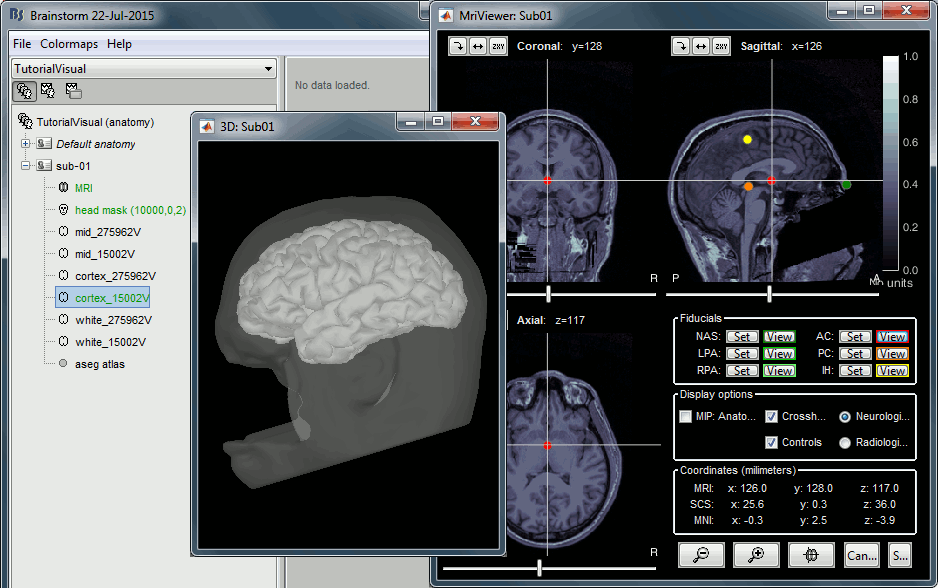
All the anatomical atlases generated by FreeSurfer were imported automatically: the surface-based cortical atlases and the atlas of sub-cortical regions (ASEG).
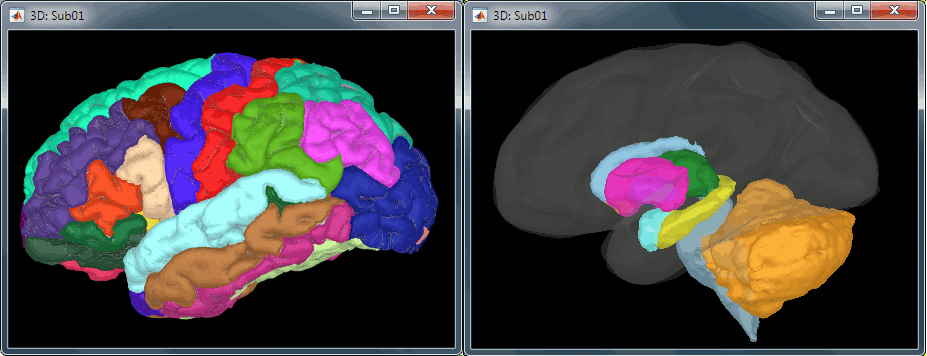
Access the recordings
Link the recordings
- Switch to the "functional data" view.
Right-click on the subject folder > Review raw file.
Select the file format: "MEG/EEG: Neuromag FIFF (*.fif)"
Select the first FIF files in: Sub01/MEEG
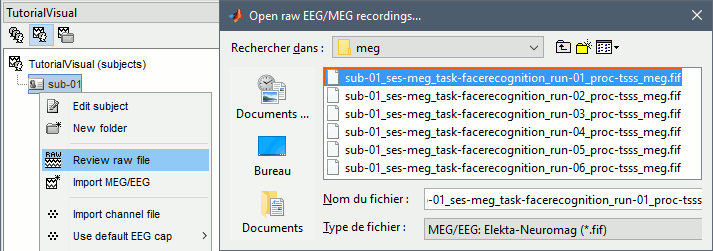
Events: Ignore
We will load the trial definition separately.
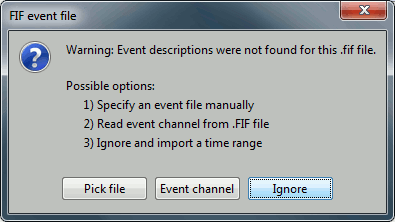
Refine registration now? NO
The head points that are available in the FIF files contain all the points that were digitized during the MEG acquisition, including the ones corresponding to the parts of the face that have been removed from the MRI. If we run the fitting algorithm, all the points around the nose will not match any close points on the head surface, leading to a wrong result. We will first remove the face points and then run the registration manually.Right-click on the channel file > Digitized head points > Remove points below nasion.
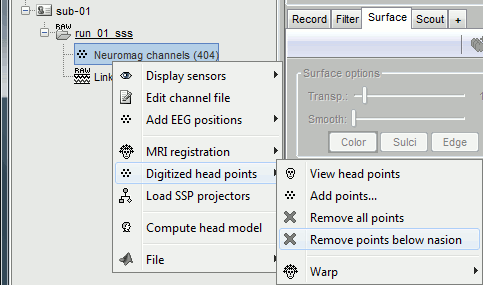
Right-click on the channel file > MRI registration > Refine registration.
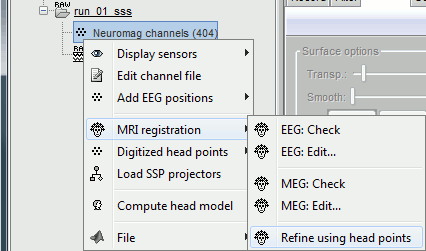
MEG/MRI registration, before (left) and after (right) this automatic registration procedure:
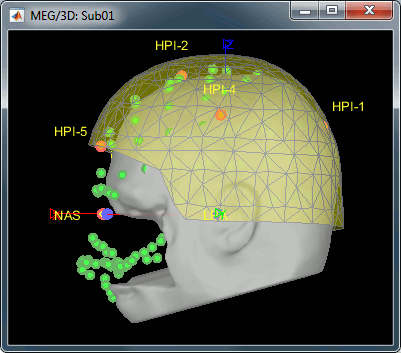
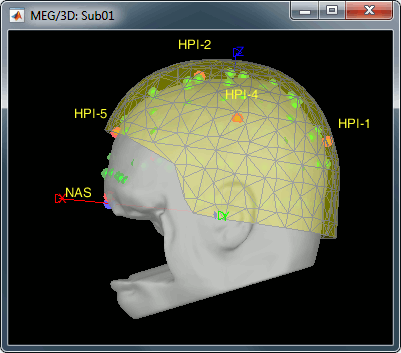
Right-click on the channel file > MRI registration > EEG: Edit...
Click on [Project electrodes on surface]
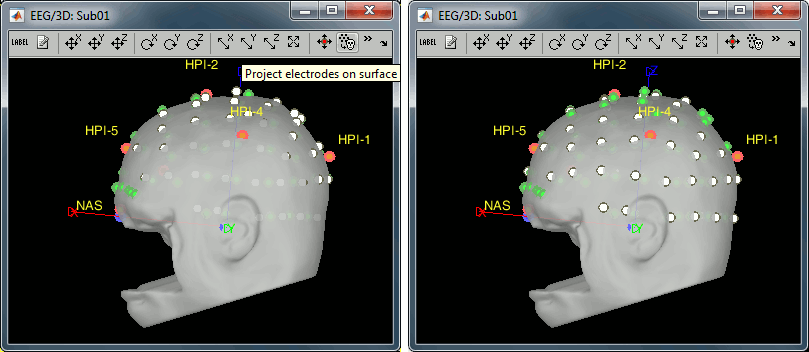
Right-click on the "Link to raw file" > MEG (all) > Display time series.
![[ATTACH] [ATTACH]](/moin_static1911/brainstorm1/img/attach.png)
In the Record tab, menu File > Add events from file:
Select the file format: "FieldTrip trial definition (*.txt;*.mat)"
Select the first text file: Sub01/MEEG/Trials/run_01_trldef.txt
![[ATTACH] [ATTACH]](/moin_static1911/brainstorm1/img/attach.png)
- There are two event categories created for each condition: the first one (eg. "Famous") represents when the stimulus was sent to the subject, the second (eg. "Famous_trial") is an extended event that represents the trial information that was present in the file.
Spectral evaluation
Run process "Frequency > Power spectrum density (Welch)" with the options illustrated below.
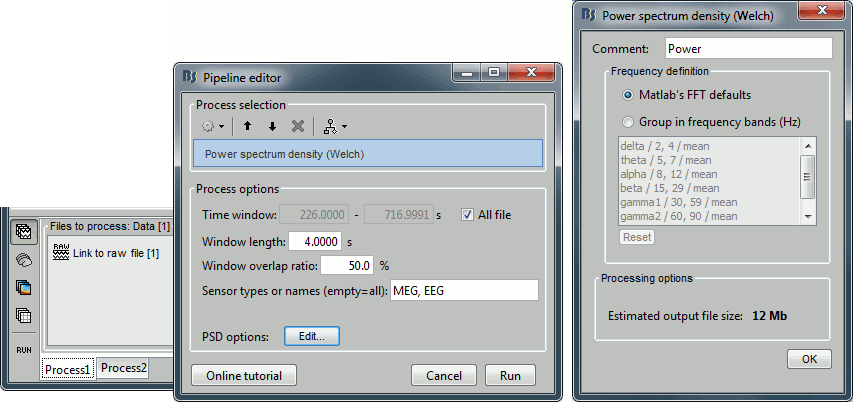
Right-click on the PSD file > Power spectrum.
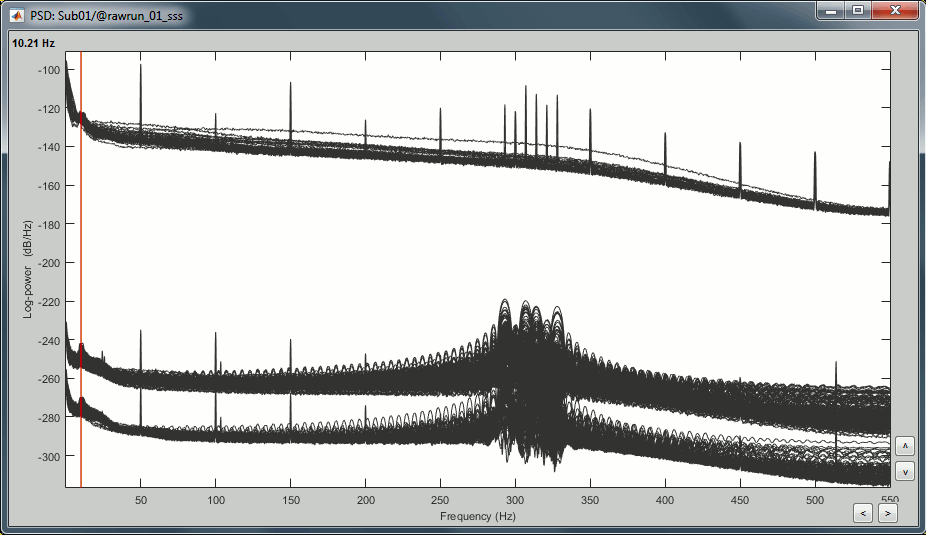
- Observations:
- Three groups of sensors, from top to bottom: EEG, MEG gradiometers, MEG magnetometers.
- Power lines: 50 Hz and harmonics
- Alpha peak around 10 Hz
- Artifacts due to Elekta electronics: 293 Hz, 307 Hz, 314 Hz, 321 Hz, 328 Hz.
- Bad EEG channels: EEG016, EEG063, EEG064
Remove line noise
- Keep the "Link to raw file" in Process1.
Run process "Pre-process > Notch filter" to remove the line noise (50-200Hz) from the MEG.

- Run the process "
Epoching and averaging
